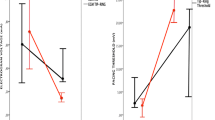Abstract
Background: Catheter based “maze” procedures for atrial fibrillation have been hampered by difficult creation and evaluation of continuous and transmural linear lesions. Our aim was to develop an online evaluation method for effective lesion creation based on conventional techniques and using the multipolar ablation catheter, already in place.
Methods and Results: We created 15 linear lines in right atria of 13 anesthetized sheep using three multipolar catheter designs (8 × 4 mm 7 Fr, 4 × 6 mm 7 Fr, 8 × 4 mm 3.7 Fr). The lesions were placed on the right posterolateral wall between the orifices of the superior and inferior vena cava. Radiofrequency energy was applied in the temperature-controlled mode to prespecified endpoints (electrogram amplitude decrease to ≤50%; pacing threshold increase by ≥100%; split potentials indicating conduction block). Macroscopically transmural and continuous lesions were achieved in only 3 experiments (29 ± 12 mm × 5 ± 1 mm), all created by 3.7 Fr octapolar catheters inserted through long sheaths. Preset temperature was reached in 96% of the electrodes (vs. 64% in the non-effective experiments; p < 0.01). Electrogram amplitude decrease (to ≤50%) and pacing threshold increase (by ≥100%) did not predict effectiveness. The only criterion that could reliably predict transmural continuous necrosis at histology was the development of split potentials (p ≤ 0.05).
Conclusions: Effective creation of linear lesions is difficult. Pliable catheters that conform to the endocardial contour give the best results. The only endpoint that reliably predicted histological transmural continuous necrosis was development of split potentials indicating conduction block.
Similar content being viewed by others
References
Moe GK. On the multiple wavelet hypthesis of atrial fibrillation. Archives Internationales de Pharmacodynamie 1962;140:183–188.
Haissaguerre M, Jais P, Shah DC, Takahashi A, Hocini M, Quiniou G, Garrigue S, Le Mouroux A, Le Metayer P, Clementy J. Spontaneous initiation of atrial fibrillation by ectopic beats originating in the pulmonary veins. N Engl J Med 1998;339:659–666.
Cox JL, Boineau JP, Schuessler RB, Kater KM, Lappas DG. Five-year experience with the maze procedure for atrial fibrillation. Ann Thorac Surg 1993;56:814–823; Discussion 823-824.
Swartz JF, Pellersels G, Silvers J, Patten L, Cervantez D. A catheter-based curative approach to atrial fibrillation in humans. Circulation 1994;90: I-335.
Haissaguerre M, Marcus FI, Fischer B, Clementy J. Radiofrequency catheter ablation in unusual mechanisms of atrial fibrillation: report of three cases. J Cardiovasc Electrophysiol 1994;5:743–751.
Haissaguerre M, Jaïs P, Shah DC, Gencel L, Pradeau V, Garrigues S, Chouairi S, Hocini M, Le Métayer P, Roudaut R, Clémenty J. Right and left atrial radiofrequency catheter therapy of paroxysmal atrial fibrillation. Journal of Cardiovascular Electrophysiology 1996;7:1132–1144.
Jumrussirikul P, Atiga WL, Lardo AC, Berger RD, Halperin H, Hutchins GM, Calkins H. Prospective comparison of lesions created using a multipolar microcatheter ablation system with those created using a pullback approach with standard radiofrequency ablation in the canine atrium. Pacing Clin Electrophysiol 2000;23:203–213.
Liem LB, Pomeranz M, Riseling K, Anderson S, Berry GJ. Electrophysiological correlates of transmural linear ablation. Pacing Clin Electrophysiol 2000;23:40–46.
Gasparini M, Coltorti F, Mantica M, Galimberti P, Ceriotti C, Beatty G. Noncontact system-guided simplified right atrial linear lesions using radiofrequency transcatheter ablation for treatment of refractory atrial fibrillation. Pacing Clin Electrophysiol 2000;23: 1843–1847.
Willems S, Weiss C, Ventura R, Ruppel R, Risius T, Hoffmann M, Meinertz T. Catheter ablation of atrial flutter guided by electroanatomic mapping (CARTO): a randomized comparison to the conventional approach. J Cardiovasc Electrophysiol 2000;11:1223–1230.
Gepstein L, Hayam G, Shpun S, Cohen D, Ben-Haim SA. Atrial linear ablations in pigs. Chronic effects on atrial electrophysiology and pathology. Circulation 1999;100:419–426.
Garg A, Finneran W, Mollerus M, Birgersdotter-Green U, Fujimura O, Tone L, Feld GK. Right atrial compartmentalization using radiofrequency catheter ablation for management of patients with refractory atrial fibrillation. J Cardiovasc Electrophysiol 1999;10:763–771.
Ernst S, Schluter M, Ouyang F, Khanedani A, Cappato R, Hebe J, Volkmer M, Antz M, Kuck KH. Modification of the substrate for maintenance of idiopathic human atrial fibrillation: efficacy of radiofrequency ablation using nonfluoroscopic catheter guidance. Circulation 1999;100:2085–2092.
Heidbuchel H, Willems R, van Rensburg H, Adams J, Ector H, Van de Werf F. Right atrial angiographic evaluation of the posterior isthmus: relevance for ablation of typical atrial flutter. Circulation 2000;101:2178–2184.
Olgin JE, Kalman JM, Chin M, Stillson C, Maguire M, Ursel P, Lesh MD. Electrophysiological effects of long, linear atrial lesions placed under intracardiac ultrasound guidance. Circulation 1997;96:2715–2721.
Roithinger FX, Steiner PR, Goseki Y, Liese KS, Scholtz DB, Sippensgroenewegen A, Ursell P, Lesh MD. Low-power radiofrequency application and intracardiac echocardiography for creation of continuous left atrial linear lesions. J Cardiovasc Electrophysiol 1999;10:680–691.
Ndrepepa G, Schneider MA, Vallaint A, Zrenner B, Karch MR, Schreieck J, Henke J, Schomig A, Schmitt C. Acute electrophysiologic effects and antifibrillatory actions of the long linear lesions in the right atrium in a sheep model. J Interv Card Electrophysiol 2000;4:529–536.
Avitall B, Helms RW, Koblish JB, Sieben W, Kotov AV, Gupta GN. The creation of linear contiguous lesions in the atria with an expandable loop catheter. J Am Coll Cardiol 1999;33:972–984.
Taylor GW, Walcott GP, Hall JA, Bishop S, Kay GN, Ideker RE. High-resolution mapping and histologic examination of long radiofrequency lesions in canine atria. J Cardiovasc Electrophysiol 1999;10:1467–1477.
Mitchell MA, McRury ID, Everett TH, Li H, Mangrum JM, Haines DE. Morphological and physiological characteristics of discontinuous linear atrial ablations during atrial pacing and atrial fibrillation. J Cardiovasc Electrophysiol 1999;10:378–386.
Weiss C, Antz M, Thuneke F, Meinertz T, Kuck KH, Willems S. Radiofrequency catheter ablation using long coiled electrodes: impact of irrigation on lesion dimensions and incidence of coagulum formation. Pacing Clin Electrophysiol 2001;24:933–938.
Author information
Authors and Affiliations
Corresponding author
Rights and permissions
About this article
Cite this article
van Rensburg, H., Willems, R., Holemans, P. et al. Simultaneous Creation and Evaluation of Linear Radiofrequency Lesions. J Interv Card Electrophysiol 6, 215–224 (2002). https://doi.org/10.1023/A:1019553619013
Issue Date:
DOI: https://doi.org/10.1023/A:1019553619013




